These Free Holiday Schedule Templates in MS Word and MS Excel format can assist you in planning a dream holiday tour this year.
The “Holiday Schedule” is a schedule of holidays that are planned for closing businesses or running businesses with few working hours. Hence, the management of the staffing, customer expectations, and work organization is done based on the need to take into account that there are days when business operates at different times due to national or local holidays.
Workers can put up holiday calendars early so that they make good schedules of their working and free hours. Customers benefit by knowing when services might be down. This is because it’s easier to plan for off days whenever national holidays are due alongside some other specific weekdays for individual companies like quarterly offsite retreats.
To make sure that it is clear and useful for both employees and management, a well-structured Holiday Schedule should have several key components. Here are the essential components:
- List of Holidays: Write down all the holidays when the company won’t be working or will be working for fewer hours as clearly as possible. Make sure the list includes all holidays that are celebrated on a national, regional, and local level in the place where the business is, and those that are celebrated only by that particular business.
- Dates and Days: List each holiday with its specific date and day of the week for planning your schedule effectively, It is especially important for an employee’s schedule this is because some holidays like Thanksgiving in the US fall on different dates each year as same as Easter.
- Hours of Operation: Specify any changes to normal operating hours if a business does not fully close on a holiday. For instance, if a business customarily terminates early on some holidays, ensure that you clearly mark those adjusted hours.
- Policy Details: Incorporate any specific policies regarding holiday pay, overtime, and necessary qualifications for holiday work. This is especially crucial in industries such as retail stores or medical facilities, where staff may be required to provide services during holidays.
- Year: Make sure the year is specified in the schedule because the dates of holidays can vary yearly.
- Contact Information: During vacations, be sure to have your questions answered or emergencies attended to by finding who is available for that. This will help you resolve problems in cases where conventional support services are not provided.
- Distribution and Access: Please show how the staff will receive the schedule and know where to find it. This may be on an intra email; employee portal or tangible posters at common places around them.
With these inclusions, an Employee Schedule for Holidays can maintain uninterrupted operations on holidays while enabling staff to plan their days off adequately.
Free Holiday Schedule Templates
Here is my collection of Free Holiday Schedule Templates that I have created using MS Word to help you out.
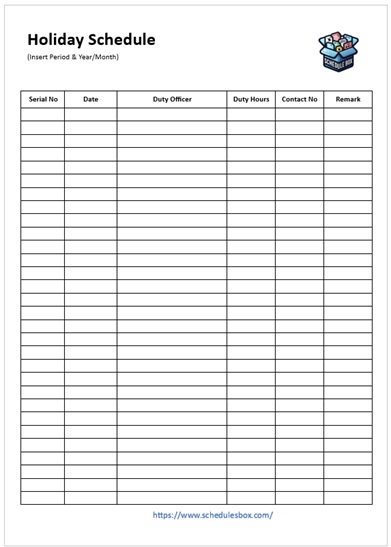
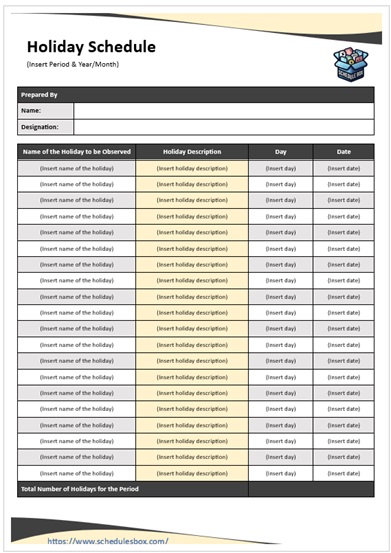
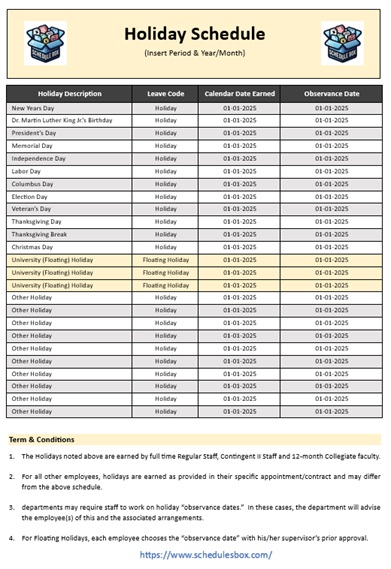
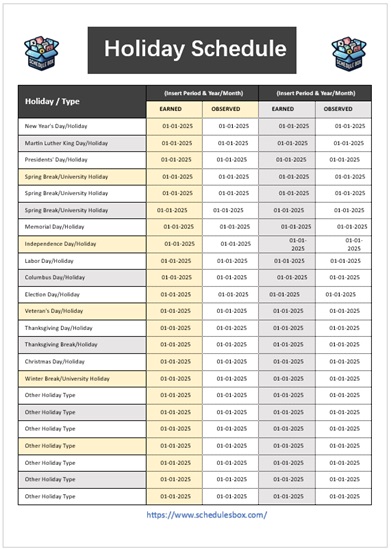
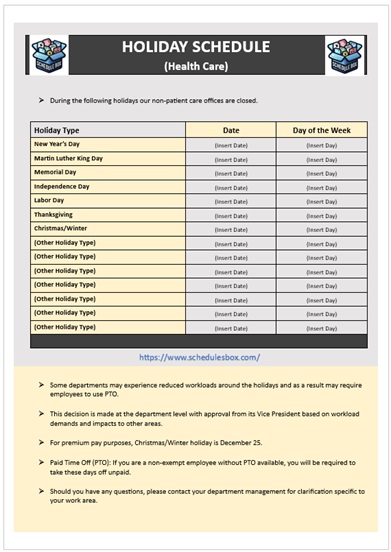
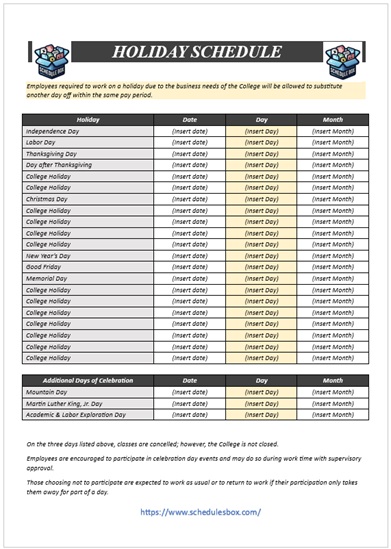
Types of Holiday Schedules
Depending on the nature of a business, where it is situated, and what needs to be done on a regular basis, its vacation policy may differ a lot. Here are some common types of holiday schedules found in various industries and organizations:
- Standard Public Holiday Schedule:
- This agenda contains days that are celebrated as public holidays internationally like Christmas, New Year’s Day, and Independence Day among others. These are normally obligatory holidays made so by government laws.
- Rotating Holiday Schedule:
- Such a work arrangement enables employees to have time off on public holidays by ensuring an employee is always on shift; thus, the organization remains open during such times. It mostly occurs within the health sector, security services, and power companies.
- Floating Holidays:
- Several organizations have flexible holidays where employees have the option of deciding when to have a day off besides the default holidays. The motive behind this is that some workers may want to mark religious or cultural days that are not recognized in formal terms by their employer.
- Restricted Holidays:
- Employers give their employees a choice of several days which they can take off as holidays. These dates usually cater to a multitude of cultural and religious practices. It is up to employees to determine which holidays matter most to them.
- Extended Holiday Breaks:
- During major holidays such as Christmas or summer vacation, organizations especially schools together with certain companies may cease their operations completely for quite some time hence leading to extended periods of closure.
- Staggered Holidays:
- Some employers plan for their employees to take leave at different times during the year in order to keep their system running and to avoid shutting it down entirely. The case applies especially where the peak working seasons coincide with different holidays.
- Partial Holiday Schedules:
- There are times, as is seen in retail or customer service scenarios when firms do not completely close their doors but instead reduce their working hours over festive seasons. This means that staff could operate in shifts so as to feasibly accomplish this.
- Emergency Services Schedule:
- During a special holiday, key functions are ensured to be fully staffed in essential services such as hospitals, fire departments, and police. This typically requires payment of holiday allowances with shifts and rotations involved.
Organizations make each kind of holiday schedule while bearing in mind the needs of both the organization and its employees in mind; these often reflect specific operational requirements and cultural context.




